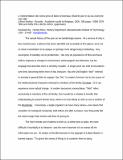Review of L'interprétation des noms grecs et latins d'animaux illustrée par le cas du zoonyme seps-sēps
Author(s)
Ritvo, Harriet
Downloadbodson.anthrozoosrev.pdf (58.68Kb)
OPEN_ACCESS_POLICY
Open Access Policy
Creative Commons Attribution-Noncommercial-Share Alike
Terms of use
Metadata
Show full item recordAbstract
The natural history of the past can be tantalizingly elusive. At a remove of only a few hundred years, evidence that seems plentiful and accessible at first glance, turns out on closer examination to be opaque or (perhaps more dangerously) misleading. Any assumption of stability can be problematic. Not only do populations of flora and fauna shift in response to changes in environment, anthropogenic and otherwise, but the language that describes them is similarly mutable. A single word can shift its boundaries over time, becoming either more or less inclusive: thus the Old English “deor” referred to animals in general (like its cognate “das Tier” in modern German), but in the course of the medieval period it became restricted to members of the family Cervidae. Or it can experience more radical change. In modern taxonomic nomenclature, “felis” refers exclusively to members of the cat family, but it would be a mistake to transfer that understanding to ancient Roman texts, where it is more likely to refer to one or another of the Mustelidae. Conversely, a single organism can have many names—one reason that compilers of zoological compendia, both before and after Linnaeus, have frequently felt the need to begin their entries with lists of synonyms.
Date issued
2011-01Department
Massachusetts Institute of Technology. Department of Humanities. History SectionJournal
Anthrozoos
Publisher
Berg Publishers
Citation
Ritvo, Harriet. "Review of L'interprétation des noms grecs et latins d'animaux illustrée par le cas du zoonyme seps-sēps" by Liliane Bodson. Brussels: Académie royale de Belgique, 2009. 368 pages. Anthrozoos 24.2 (June 2011) pp. 223-224.
Version: Author's final manuscript
ISSN
0892-7936
1753-0377